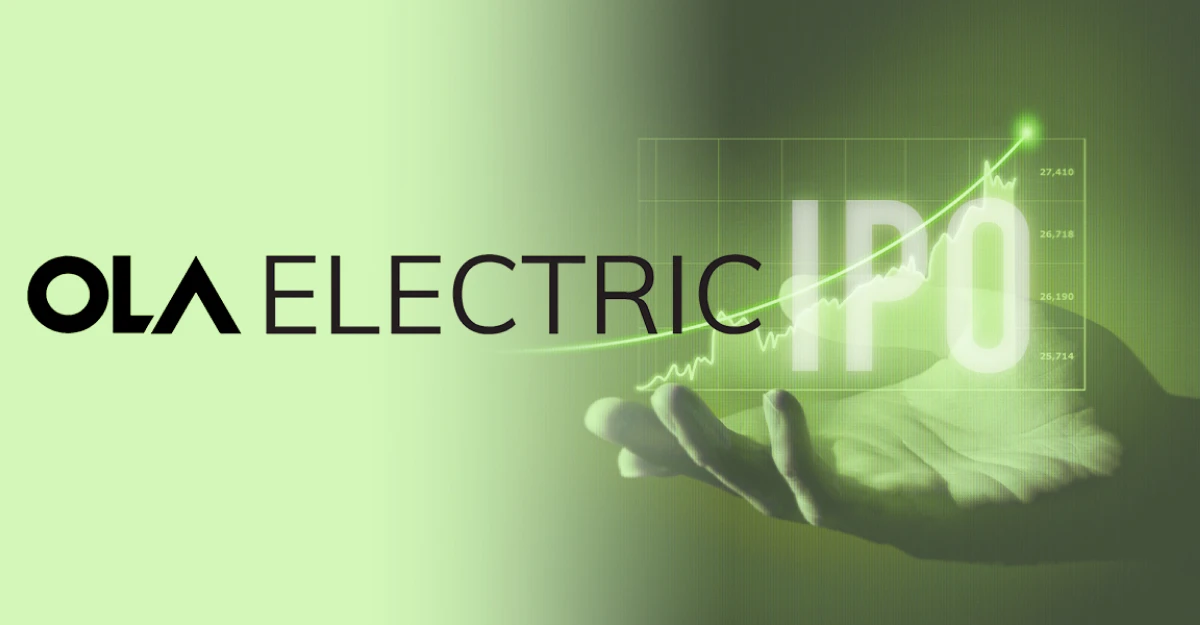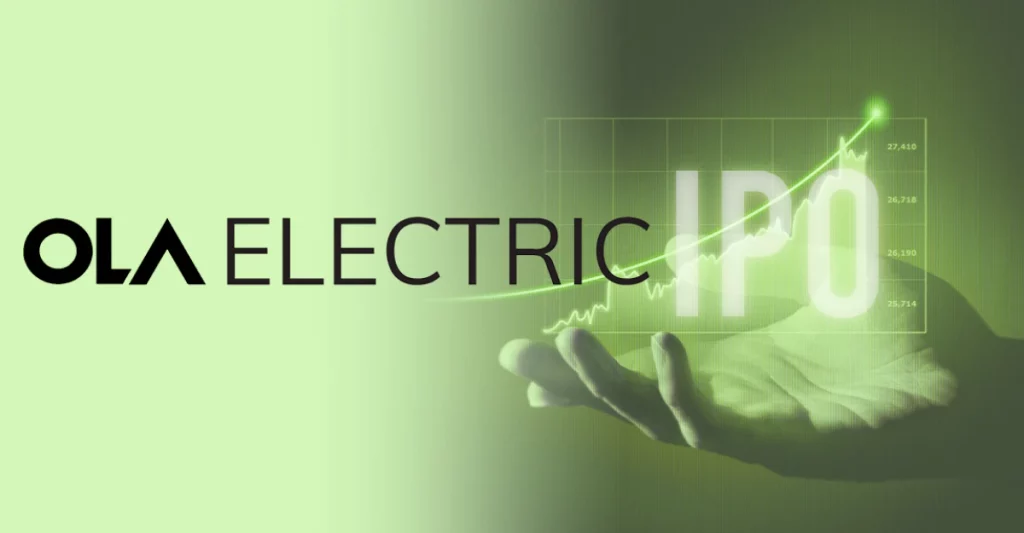With a valuation of $4.4 billion, Ola Electric IPO is making waves as it is the first-ever Initial Public Offering by Bhavish Aggarwal, the company’s founder. Opening on August 2, 2024, this IPO is worth Rs.5,500 crore. The excitement around this IPO stems from Ola Electric’s impressive growth and ambitious plans for the future.
Let’s go through the 5 interesting facts about the upcoming Ola Electric IPO!
1. Game-Changing Gigafactory in Tamil Nadu worth Rs.1,227.6 Cr Investment

Here is some exciting news about Ola Electric’s IPO. One of the most fascinating developments is their investment in a massive manufacturing hub in Tamil Nadu. This isn’t just any factory; it’s a Gigafactory set to revolutionize Ola’s production capabilities and technological advancements.
Major Investment for Expansion
Ola Electric is set to invest a whopping Rs.1,227.6 crore to expand its manufacturing capacity at this Gigafactory in Tamil Nadu. This significant investment highlights Ola’s commitment to scaling up its operations and solidifying its position in the electric vehicle market.
Cutting-Edge Cell Technology
The Gigafactory isn’t just about ramping up production; it’s a hub for developing advanced cell technology and manufacturing processes. One of the key highlights of this facility is its focus on the pioneering 4680 cell technology. This state-of-the-art battery innovation center is dedicated to spearheading the development of cutting-edge cell and battery technology.
Impressive Production Capacity
Initially, the Gigafactory will have a production capacity of 1 GWh for 4680 cells, with plans to expand this to a staggering 20 GWh. This scalability is crucial for meeting the growing demand for electric vehicles and ensuring Ola Electric remains at the forefront of the industry.
World-Class Manufacturing Facility
The Gigafactory is designed as a world-class manufacturing facility, incorporating in-house electrode production, cell assembly, and cell formation. This integrated approach ensures high-quality production standards and enhances operational efficiency.
Operational Timeline
Mark your calendars for the financial year 2025! That’s when Phase 1 of the plant is expected to be operational. This timeline is ambitious but achievable, reflecting Ola’s aggressive strategy to accelerate its market presence and technological capabilities.
Strategic Importance
This Gigafactory in Tamil Nadu is a strategic asset for Ola Electric. It not only boosts production capacity but also positions the company as a leader in battery technology. By focusing on the 4680 cell technology, Ola is setting new benchmarks in battery performance and efficiency, critical factors for the success of electric vehicles.
2. Revenue Rose 90% to Rs.5,009.8 Cr while losses surged to Rs.1,584 crore In FY23

Ola Electric’s financial performance is a mix of impressive revenue growth and increasing losses. For FY24, the company reported revenue from operations at Rs.5,009.8 crore, which is a significant jump from Rs.2,630.9 crore in FY23.
All thanks to its electric two-wheelers. Yes! This surge in revenue is primarily driven by the booming sales of their e-scooters, which have secured over 50 percent market share, solidifying Ola Electric’s dominance in the EV market.
However, this impressive revenue growth comes with a downside – rising losses. The company reported a loss of Rs.1,584.4 crore in FY24, up from Rs.1,472 crore in FY23. The widening losses are mainly due to increased expenses as the company continues to invest in expanding its business and product portfolio.
Despite the losses, Ola Electric remains optimistic, targeting an EBITDA profitability of Rs.803 crore in FY25 and projecting a revenue of Rs.4,655 crore for FY24.
Note: A few months ago the market was buzzing with the discussion on whether Ola Electric IPO will be a success or not. We have thoroughly explained this speculation with data here- A Complete Breakdown of Ola Electric IPO’s success/failure.
3. Ola Maps Replaces Google Maps reducing the Spending from Rs.100 Crore to Rs.0
Ola Electric is making headlines as it prepares for its IPO, not just for its innovative electric vehicles but also for a bold move in the mapping arena. Earlier this month, Bengaluru-based Ola introduced Ola Maps, a homegrown substitute for Google Maps, signaling a major shift in its operations.
A Bold Move by Ola
In a post on X (formerly Twitter), Bhavish Aggarwal, the chief executive of Ola Cabs, announced the transition- “After Azure exit last month, we’ve now fully exited Google Maps. We used to spend Rs.100 crore a year but we’ve made that zero this month by moving completely to our in-house Ola Maps! Check your Ola app and update if needed.”
This move is not just about cutting costs; it’s about asserting independence and innovation.
Impact on Google Maps
Ola’s switch to its own mapping service has had a significant ripple effect. Following Aggarwal’s announcement, Google Maps reduced its prices by a staggering 70% for developers in India. This price cut, effective from August 1, introduced a new country-specific pricing structure and began accepting subscription payments in rupees, a shift from its previous US dollar-only policy.
Competitive Pricing and Local Alternatives
Google’s response also included a 90% discount for developers working with the Open Network for Digital Commerce (ONDC), an initiative by the Department for Promotion of Industry and Internal Trade (DPIIT). This steep price reduction is unprecedented for Google Maps in India, highlighting the pressure from local alternatives like Ola Maps and MapMyIndia.
Aggarwal had called on Indian startups to support local mapping solutions. To bolster this appeal, Ola Maps is offering one year of free access to all developers. This move aims to challenge Google Maps’ dominance and promote homegrown technology solutions.
Aggarwal’s Response and Industry Impact
Aggarwal’s reaction to Google’s pricing strategy was sharp and direct. He tweeted, “Dear @Google, too little too late! Reducing prices for @googlemaps, ‘offering to price in ₹’ after #ExitGoogleMaps. Don’t need your fake generosity…” This isn’t the first time Aggarwal has taken on a global tech giant. In May, he transitioned Ola’s workload from Microsoft’s cloud platform Azure to Ola’s own ‘Krutrim’.
Financial and Strategic Benefits
This strategic shift to Ola Maps is expected to save the company Rs 100 crore annually, a significant cost reduction as it gears up for the IPO. By developing in-house solutions, Ola not only cuts costs but also builds a stronger technological foundation, reinforcing its innovative edge in the electric vehicle market.
4. Controversy before IPO: Legal Battle with MapMyIndia
Ola Electric is facing a serious accusation from CE Info Systems, the parent company of MapMyIndia. According to Forbes India, MapMyIndia has issued a legal notice to Ola Electric, claiming that Ola copied its data to create its own mapping service, Ola Maps.
Partnership Gone Wrong
Back in 2022, Ola Electric partnered with MapMyIndia to provide navigation services for its S1 Pro electric scooter. The agreement had strict clauses- Ola was prohibited from integrating MapMyIndia’s licensed product with any similar competing product and from reverse engineering or extracting source code.
Allegations of Data Theft
MapMyIndia alleges that Ola Electric didn’t stick to the rules. The legal notice accuses Ola of duplicating MapMyIndia’s API and SDKs. CE Info Systems asserts, “You have duplicated our client’s API and SDKs from proprietary sources belonging to our client to build OLA Maps. It is firmly stated that our client’s exclusive data has been copied/derived by you to further your illegal motive and for your unjust commercial gains.”
Disputed Claims
Ola Electric claims that Ola Maps was developed using open-source map data. However, CE Info Systems isn’t buying it. They contend that Ola’s claim is “factually incorrect and not tenable,” pointing out that the activities breach the terms of their 2021 agreement. This agreement explicitly forbade reverse engineering and the co-mingling of data.
Intellectual Property Breach
The legal notice further states, “By indulging in such unscrupulous and illegal activities, you have acted in blatant defiance of the terms and conditions of the agreement and have further infringed the copyright vested exclusively in our client pertaining to the source code.”
Impact on IPO
This controversy certainly casts a shadow over Ola Electric’s IPO. Investors are keenly watching how this legal battle unfolds, as it could impact the company’s valuation and public perception. So, while Ola Electric’s IPO is a landmark moment, this legal dispute adds a layer of intrigue and caution for potential investors.
Keep an eye on this space—things are bound to get interesting!
5. Challenges with a High Employee Turnover Rate at 44.25% in FY24

The success of Ola Electric is driven by its dedicated workforce. As of now, the company has a total of 4,011 employees, with 907 of them working in the R&D segment. The company acknowledges the need for sufficient talent in areas like software development to support its ambitious growth plans.
However, Ola Electric faces a significant challenge with a high employee attrition rate of 44.25% in FY24 and 47.48% in FY23. This high turnover rate indicates the need for the company to focus on employee retention strategies to maintain stability and ensure the continuity of its innovative projects.
Thus, the upcoming Ola Electric IPO is a landmark event with exciting potential for investors. This IPO not only marks a new chapter for the company but also signals its commitment to leading the charge in the electric vehicle revolution!

